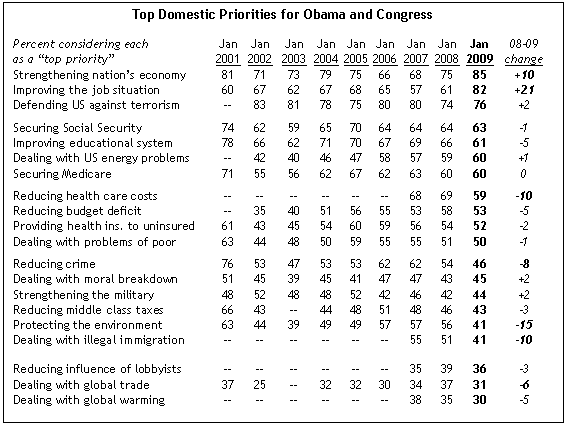You have probably already heard about a Pew survey released yesterday, which shows that out of a choice of 20 primary concerns the American public has, the economy and jobs rank at the very top, and global warming ranks at the very bottom. Here are the stats:
A couple of blogs I’ve visited this morning show considerable fretting over this situation, with calls for reframing the global warming issue in terms that hit home with people, or reducing the alarmist rhetoric, etc. In other words, the public just isn’t getting it, and the problem lies with the communicators of the global warming message.
Well, maybe the problem doesn’t lie with the communicators…but instead with the long tradition science has of overselling issues that the scientific community knows relatively little about. The public already knows that science has a history of being spectacularly wrong with long-term predictions of doom. Paul Ehrlich’s Population Bomb bombed, and yet many people still fret over the Earth being overpopulated. (In my view, the only thing we are overpopulated with is stupidity).
And the time it takes for science to realize that the ‘scientific consensus’ is wrong can be very, very long indeed. For instance, as early as 1948 it was learned that administering antibiotics to farm animals eliminated the incidence of stomach ulcers. The medical community was told about this and they considered the idea as preposterous. Finally, in 2005 two Australian scientists were awarded the Nobel Prize for “discovering” the bacterial basis of peptic ulcers. The truth is, one of them was tipped off by a rancher many years earlier to look into using antibiotics.
Gee, I wonder how much more difficult it is to come to a sufficient theoretical understanding of the sensitivity of the climate system, compared to figuring out empirically what works for the treatment of stomach ulcers…when we have had literally millions of patients to test treatments on over the years? And stomach ulcer research doesn’t carry all of the baggage that accompanies global warming research, like economics, politics, the role of government in peoples’ lives, and even our religious beliefs regarding mankind’s relationship to the environment.
And what is particularly fascinating about the Pew study is that addressing global warming (at the bottom of the list of priorities) could supposedly help the economy (at the top of the list). If Obama really believes his own rhetoric about green energy creating green jobs as a way of invigorating the economy, he should be making alternative energy a top priority.
But the dirty little secret is that renewable energy is very expensive and requires large areas of land to be used for its generation…which then has its own environmental impact. I’m attending a PowerSouth electric utility cooperative meeting where the trustees are fretting over where our future energy will come from. While most of the energy producers in America are investor-owned, and will simply pass higher prices on to consumers (with investors continuing to take a piece of the pie), the electric co-ops are more interested in keeping prices low because they are looking out for their customers.
The most interesting presentation I’ve seen at the meeting so far compared the energy content of various energy sources to how much real estate it takes to create that energy. Ethanol was absolutely the worst, with huge amounts of land required to generate relatively little energy. Nuclear power is, of course, at the other end of the spectrum, with a huge amount of energy being generated with very little land.
But the future (it was claimed by the presenter) is with methane and natural gas, large deposits of which are being found under the ocean floor. If one compared how much hydrogen energy is contained in various fuels compared to their carbon content (and thus how much CO2 is produced when the are burned), the order from worst to best runs: wood & biomass, coal, petroleum, natural gas, methane, and pure hydrogen. (Since there are no natural deposits of hydrogen, it’s inclusion is somewhat irrelevant).
And the infrastructure required to retrieve and use these gases to fire electric turbines takes up very little space. His view was that methane IS renewable, continuously being generated by microbes in the Earth’s crust.
Whether these sources will help solve our energy problems, I have no idea. But if for no other reason that the physical limits on how much energy we can get out of one acre of wind, solar, biomass, etc., I predict we will never substantially reduce CO2 emissions until we embrace nuclear once again, or develop some other new energy technology which we, at this point, can only dream about.
(Of course, if you have read my writings, you already know my research suggests that the climate system is relatively insensitive to the CO2 we produce, anyway.)
The energy needs of humanity are so vast (and growing, especially in India and China) that we can only stay economically competitive if we abandon ideas which provide a poor return on investment, and remain open to ideas that might at first seem preposterous…such as using antibiotics to treat ulcers.

 Home/Blog
Home/Blog




